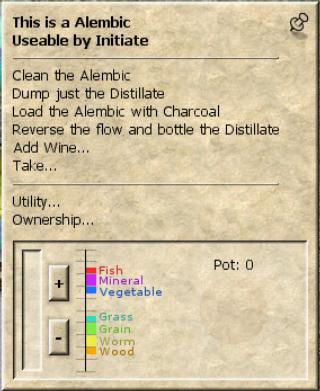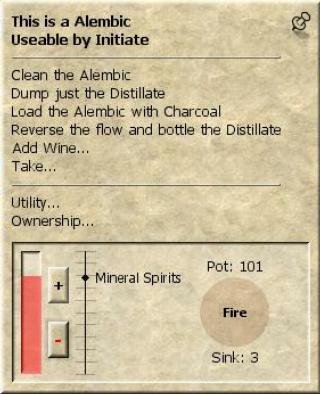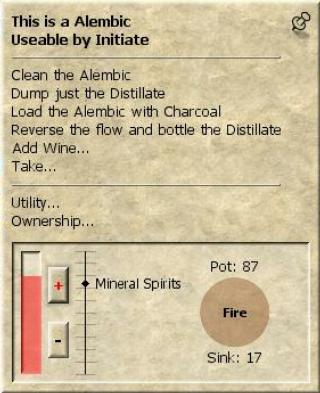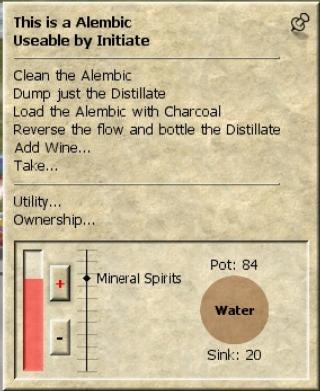Distillation
EldradUlthran's Distillation Guide.
From Distillation Experiments
After much research we concluded that there are in fact nine different chemical components that make up Spirits. Each has a different boiling point, and due to the valve mechanism on an alembic, it is possible to boil off just those spirits with a boiling point equal to the solution temperature (rather than those equal or above.)
The nine types of spirits from lowest boiling point to highest are: Rock, Wood, Worm, Grain, Grass, Fruit, Vegetable, Mineral, Fish. Spirits are then further categorized by purity level, with the most pure referred to as Spirits of Ra, followed by Spirits of Life, Air, Fire, Water, Earth. The term Grey Spirits indicates that either the spirit is even less pure than Earth spirits, *or* contains compounds with an average boiling point above Fish Spirits.
Not all distillable materials contain all spirit types. Beer, for example contains Wood, Worm, Grain, and Grass spirits. Beers with the 'Dry' flavor also contain small amounts of Fruit and Vegetable Spirits. Potent beers contain 25% more spirits total than normal beers. Very Potent Beers contain 50% more.
The pressure and heat of an albemic cause a chemical reaction in wine whereby tanis are converted into Wood, Worm, Grain, and Grass spirits. Residual sugar further increases the spirits' weight, providing vegetable, mineral, and fish spirits. Since the condensing stage of an Alembic tends to average the weights of the circulating components, it is theoretically possible to distall intermediate types of spirits by distalling a high boiling point spirit such as Vegetable, and then a bit of a low boiling point spirit like Grass. When this is done, the result would be Fruit Spirits. It is unknown whether these can be made with enough purity to prevent classification as Grey Spirits.
Spirits Tutorial by Degas
I'm going to try to keep this as simple as possible. Making Spirits is a complex process, however, and some involved explanation is necessary. I apologize in advance if you find some of this tough to get through. As a player who was not present in previous tellings, I have found some of the "explanations" on this wiki to be entirely too complicated for my limited comprehension. The authors, all with good intentions, have sometimes based their writings on assumed knowledge from previous Tales. Having said that, let's begin...
Spirits are distilled from Wine or Beer in an Alembic. There are at least 8 possible "Types" of spirits: Wood, Worm, Grain, Grass, Vegetable, Mineral, Fish, and Grey Spirits. In addition, all spirits but "Grey" have 6 possible purity levels: Earth, Water, Fire, Air, Life and Ra. Thus, for example, you will see a certain spirit referred to as "Mineral Spirits of Water". The "Type" of spirit is determined by the temperature of the Alembic when you add the wine or beer. Temperature is controlled by pressing either the " + " or " - " button in the alembic controls. A red bar begins filling the scale in the left of the window. As temperature rises, so does the red bar. Here is a screenshot of the Alembic controls, with the temperature range required to distill each "Type" of spirit.
Now let's see a practical example of the process as it unfolds. In this screenshot, you will see that I have heated the Alembic to the Mineral Spirits range:
At this point, I add my wine. In this next screenshot, you can see that the button on the slider is now labelled "Mineral Spirits". Once you have the "Mineral Spirits" label next to the dot on the slider, and are keeping the temperature as steady as possible, you will eventually see the "spot" on the right of the scale change color, and it will display the "purity level" of the spirits that you have boiled off so far into the "sink". You will also see that there are now 101 raw spirits in the "Pot", and that there are 3 Fire Spirits in the "Sink":
The amount of raw spirits available depends on the tannin level, residual sugar, and possibly the alcohol percentage of the wine being used. Current testing seems to show that tannin weights the spirits toward the lower temperatures (Wood, Worm, Grain and Grass), while residual sugar controls the amount of higher temperature spirits (Vegetable, Mineral, Fish). A good all-around spirit wine will have both high tannin and high residual sugar.
The objective is to carefully boil off different levels of "pure" spirits. Once you add the wine, it's all about temperature control. You need to keep the top of the red bar as close as possible to the dot on the slider. Keep in mind, there is a random factor to how much the temperature will drop or raise with each "tick" in time. This means that luck will always play a factor in how successful you are. You need a combination of the right type of wine or beer and very fine temperature control to make any type of "Spirits of Ra", for example. Not all wines/beers will contain these exremely pure spirits. Fortunately, there are uses for almost every "Type" of spirit. Since spirits of Fire seem to be the most useful in distilling Essences, I decide that I'm going to try for Mineral Spirits of Fire. My next step is to continue controlling the temperature until I have produced the maximum number of Mineral Spirits of Fire that I can distill from this particular wine:
Now, as I continue to keep careful control of the temperature, I will continue to distill more Fire spirits into the sink. At some point, however, the distillation will yield no more spirits of Fire from this wine, no matter how long I control the temperature at the desired level. Notice how the "spot" is now darker? The color changes depending on the purity of the spirits in the sink. Purity is calculated based on the average of all spirits in the sink. The color in the above screenshot is telling me that I have almost pushed this too far. Trying to go further would drop the purity to Spirits of Water. So, I have a choice: accept the results and bottle what Fire spirits I've managed to produce, or drop my expectations and produce the next lowest level of "purity" in greater numbers. Here's what I mean:
At this point, I just continued working the temperature until I felt like I had reached the maximum amount of Mineral Spirits of Water possible. In this particular case, that number was 27. If I hadn't been taking screenshots for this tutorial, I would have bottled the 17 Fire spirits.
You will notice that I have not included anything about making spirits from beer. My apologies. The fact is, I have never tried it ;) However, I hope this explanation is of some help to you. If you get stuck, or have questions, please feel free to contact me in the game. I'll help if I can. Also, if you have corrections to some of my assumptions regarding things like the effects of different wine statistics on the production of spirits, feel free to make them.
Best Wines
The best wines to use when distilling spirits are those that contain high levels of tannin and a reasonable level of alcohol. 12 and 13 percent alcohol work well. For example, Using a 200 Tannin, 13 percent Alcohol wine, I was able to distill 1300 Grain Spirits of Fire, and upwards of 1400 Grain Spirits of Water. In contrast, using a 6 Tannin, 12 percent Alcohol wine I was only able to get approximately 65 Grain Spirits of Water using the same macro to automate the distillation process of grain spirits. My macro will be made available when I iron out a few problems I have with the menu offsets. - Tribisha
This seems to depend a lot on what sort of spirits you're aiming for. For low-temperature spirits (Worm, Wood, Grain, Grass), high alcohol and high tannin seem to produce the best results. For high-temperature spirits, it seems to be something else -- my preliminary data would indicate that residual sugar is best for Vegetable, Mineral, and Fish spirits, but I'll need to spend some more time in the vineyards (and at the alembic) to be sure.
This is not true, i used a 0.0 alch , 128,2 tannin wine that had a potency of 2028, i tried to get some high temerature wines, but didnt even get a lock on them up there. so alch is not needed for low-temperature spirits - OnlyAloha
Tannin for low-temp spirits; residual sugar for high-temp spirits. - Yendor




